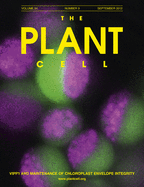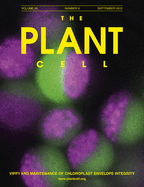
Cover image

VIPP1 AND MAINTENANCE OF CHLOROPLAST ENVELOPE INTEGRITY
Chloroplast envelope membranes are known to be damaged by environmental stresses such as heat, drought, UV-B, and element toxicity. However, how envelope integrity is maintained is largely unknown. Zhang et al. (pages
Volume 24, Issue 9, September 2012
IN BRIEF
The Molecular Mechanism of the UVR8 UV-B Photoreceptor
Why Wiry? Tomato Mutants Reveal Connections among Small RNAs, Auxin Response Factors, Virus Infection, and Leaf Morphology
Rapid Centromere Evolution in Potato: Invasion of the Satellite Repeats
LARGE-SCALE BIOLOGY ARTICLES
The Grapevine Expression Atlas Reveals a Deep Transcriptome Shift Driving the Entire Plant into a Maturation Program
The authors developed a comprehensive transcriptome atlas in grapevine by comparing the genes expressed in 54 diverse samples accounting for ∼91% of all known grapevine genes. Using a panel of different statistical techniques, they found that the whole plant undergoes transcriptomic reprogramming, driving it towards maturity.
A Systems Biology View of Responses to Lignin Biosynthesis Perturbations in Arabidopsis
The combination of metabolomics and transcriptomics on Arabidopsis thaliana lines mutated in 10 steps of the lignin pathway provides insight into monolignol biosynthesis and the metabolic network in which it is embedded. In addition, this work reveals novel pathways and genes associated with lignin biosynthesis.
Arabidopsis Defense against Botrytis cinerea: Chronology and Regulation Deciphered by High-Resolution Temporal Transcriptomic Analysis
The authors generated a high-resolution time series of Arabidopsis thaliana gene expression following infection with the fungal pathogen Botrytis cinerea. Computational analysis of this large data set identified the timing of specific processes and regulatory events in the host plant and showed a role for the transcription factor TGA3 in the defense response against the fungal pathogen.
RESEARCH ARTICLES
Repeatless and Repeat-Based Centromeres in Potato: Implications for Centromere Evolution
The authors used a genome-wide approach to identify the DNA sequences associated with the centromeres of potato chromosomes. Five potato centromeres are composed of single- or low-copy sequences, including active genes; six centromeres contain almost exclusively satellite repeats. The results have implications for evolution of repeat-based centromeres from repeatless centromeres.
Failure of the Tomato Trans-Acting Short Interfering RNA Program to Regulate AUXIN RESPONSE FACTOR3 and ARF4 Underlies the Wiry Leaf Syndrome
Tomato mutants defective in ta-siRNA production have narrow shoestring leaves reminiscent of virus-infected plants. The tomato leaf phenotype is due to deregulated ARF gene expression, but ectopic expression of the same ARF genes in related species fails to recapitulate these developmental defects, analogous to species-specific viral infection symptoms.
IAA-Ala Resistant3, an Evolutionarily Conserved Target of miR167, Mediates Arabidopsis Root Architecture Changes during High Osmotic Stress
When plants are subjected to water stress such as drought and high salt, they develop more lateral roots through reducing miRNA167 levels and indirectly increasing IAR3 mRNA levels. The increased IAR3 enzyme converts inactive auxin to the active form, which promotes root branching. This stress adaptation miRNA-mRNA pair is evolutionarily conserved.
Mutations in the Arabidopsis H3K4me2/3 Demethylase JMJ14 Suppress Posttranscriptional Gene Silencing by Decreasing Transgene Transcription
This article reveals that the H3K4me2/3 demethylase JMJ14 likely is unable to demethylate transgene loci, thus promoting high levels of transcription, which favor the triggering of posttranscriptional transgene silencing. Removing JMJ14 may allow other H3K4 demethylases to reduce transgene transcription and prevent the triggering of posttranscriptional transgene silencing.
Functional Analysis of Three Arabidopsis ARGONAUTES Using Slicer-Defective Mutants
Wild-type and active-site defective forms of several Arabidopsis thaliana ARGONAUTE proteins involved in posttranscriptional silencing were used to examine several ARGONAUTE functions, including small RNA binding, interaction with target RNA, slicing or destabilization of target RNA, secondary siRNA formation, and antiviral activity.
Overexpression of Arabidopsis Plasmodesmata Germin-Like Proteins Disrupts Root Growth and Development
Plant cells communicate by movement of signaling agents through cytoplasmic bridges, termed plasmodesmata (PD). In this study, we characterize two members of the Germin-like protein family that are located within PD. PDGLP1/2 overexpression phenotypes had a reduction in primary root meristem size, likely due to their inability to form functional PD complexes.
G Protein–Coupled Receptor-Type G Proteins Are Required for Light-Dependent Seedling Growth and Fertility in Arabidopsis
GTGs are highly conserved membrane proteins found in plants, animals, and fungi. Arabidopsis thaliana GTG1 is found in Golgi bodies and endoplasmic reticulum. GTG knockout mutants show defects in fertility, hypocotyl and root growth, and responses to light and sugars but respond normally to abscisic acid. These results show that Arabidopsis GTGs are fundamental to plant growth and development.
Subunit Organization of a Synechocystis Hetero-Oligomeric Thylakoid FtsH Complex Involved in Photosystem II Repair
An important photoprotective mechanism in plants, algae, and cyanobacteria is the selective replacement of damaged protein subunits within the oxygen-evolving enzyme of photosynthesis. This work reports the purification of the cyanobacterial FtsH protease involved in this process and shows using electron microscopy that it is a hexamer consisting of two types of alternating subunits.
Two Interacting Proteins Are Necessary for the Editing of the NdhD-1 Site in Arabidopsis Plastids
Complementary, reverse genetic, protein–protein interaction and fusion approaches reveal the requirement of at least two interacting PPR proteins for the editing of a specific site in Arabidopsis plastids.
Essential Role of VIPP1 in Chloroplast Envelope Maintenance in Arabidopsis
VIPP1 is a protein conserved among photosynthetic organisms. Although the precise role in chloroplasts remains unclear, VIPP1 has been proposed to play a role in thylakoid membrane biogenesis. This study involves an in-depth analysis of Arabidopsis thaliana vipp1 mutants and demonstrates that VIPP1 is rather required for envelope maintenance in chloroplasts.
Phospholipid:Diacylglycerol Acyltransferase Is a Multifunctional Enzyme Involved in Membrane Lipid Turnover and Degradation While Synthesizing Triacylglycerol in the Unicellular Green Microalga Chlamydomonas reinhardtii
This study presents detailed genetic, biochemical, functional, and physiological analyses of phospholipid:diacylglycerol acyltransferase (PDAT) in the green microalga Chlamydomonas reinhardtii. Multiple lines of evidence indicate that PDAT is a multifunctional protein and plays an essential role in membrane turnover, degradation, and TAG formation in C. reinhardtii.
Plastid Localization of the Key Carotenoid Enzyme Phytoene Synthase Is Altered by Isozyme, Allelic Variation, and Activity
This work examines the localization of PSY isozymes and allelic variants from maize, rice, and Arabidopsis, finding that PSY isozymes differ in chloroplast suborganellar localization and that overexpression of naturally occurring allelic variants produced striking differences in localization and profound effects on chloroplast architecture.
Capping Protein Modulates the Dynamic Behavior of Actin Filaments in Response to Phosphatidic Acid in Arabidopsis
Capping protein (CP) binds to the fast-growing ends of actin filaments and is negatively regulated by signaling lipids in vitro. This study demonstrates that the end-capping activity of CP is inhibited by membrane signaling phospholipids in living epidermal cells from Arabidopsis thaliana and that CP remodels the actin cytoskeleton in response to changes in these phospholipids.
In Vivo Function of Tryptophans in the Arabidopsis UV-B Photoreceptor UVR8
The UV-B photoreceptor UVR8 uses specific Trp amino acids in UV-B perception. This study examines the functional importance of all 14 UVR8 tryptophans in responses in plants.
YSL16 Is a Phloem-Localized Transporter of the Copper-Nicotianamine Complex That Is Responsible for Copper Distribution in Rice
Recycling of a nutrient from old tissues to young tissues is an important process for plant growth and development. This work describes a transporter for the Cu-nicotianamine complex, which is required for delivering Cu to the developing young tissues and seeds through phloem transport.
HDT701, a Histone H4 Deacetylase, Negatively Regulates Plant Innate Immunity by Modulating Histone H4 Acetylation of Defense-Related Genes in Rice
Novel Plant Immune-Priming Compounds Identified via High-Throughput Chemical Screening Target Salicylic Acid Glucosyltransferases in Arabidopsis
This study used high-throughput screening to identify five immune priming chemicals that potentiate but do not directly induce defense responses. These compounds inhibit salicylic acid (SA) glucosyltransferases and increase SA during pathogen infection. Thus, SA glucosylation can be a target for developing novel crop protectants.
HapX-Mediated Iron Homeostasis Is Essential for Rhizosphere Competence and Virulence of the Soilborne Pathogen Fusarium oxysporum
This study shows that the bZIP protein HapX, a key regulator of the iron response, is required for rhizosphere competence of the vascular wilt fungus Fusarium oxysporum against soil-inhabiting bacteria and for virulence on tomato (Solanum lycopersicum) plants and immunodepressed mice, establishing a conserved role for HapX-mediated iron homeostasis in fungal infection of plants and mammals.
Verticillium Infection Triggers VASCULAR-RELATED NAC DOMAIN7–Dependent de Novo Xylem Formation and Enhances Drought Tolerance in Arabidopsis
Arabidopsis thaliana plants infected with the soilborne fungus Verticillium longisporum generate vascular tissues with a higher number of xylem cells because of an increased rate of xylem formation and the developmental reprogramming of parenchyma cells. The newly formed xylem enhances the water storage capacity and improves the water status of infected plants under concomitant drought stress conditions.
Two Direct Targets of Cytokinin Signaling Regulate Symbiotic Nodulation in Medicago truncatula
In legume plants, cytokinins are necessary and sufficient for symbiotic nodule organogenesis, allowing them to fix atmospheric nitrogen. Biochemical and reverse genetic approaches identified two transcription factors from the GRAS (NSP2) and bHLH families as direct targets of cytokinin signaling pathways in legume roots. These transcription factors act at the convergence of phytohormonal and nodulation symbiotic cues.


